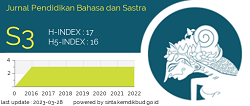Students’ Perceptions of English Medium Instruction (EMI) in Secondary School Bilingual Classes: A Case Study
Abstract
Keywords
References
Artini, L. P. (2013). Penggunaan English As Medium of Instructions (Emi) Dan Konsekuensinya Terhadap Proses Pembelajaran Ditinjau Dari Persepsi Siswa. Jurnal Ilmu Sosial Dan Humaniora, 2(1), 166–178. https://doi.org/10.23887/jish-undiksha.v2i1.1312
Baker, C. (2011). Foundations of Bilingual Education and Bilingualism. Stroud: Multilingual Matters.
Baker, W., & Hüttner, J. (2017). English and more: a multisite study of roles and conceptualisations of language in English medium multilingual universities from Europe to Asia. Journal of Multilingual and Multicultural Development, 38(6), 501–516. https://doi.org/10.1080/01434632.2016.1207183
Bialystok, E. (2018). Bilingual education for young children: review of the effects and consequences. International Journal of Bilingual Education and Bilingualism, 21(6), 666–679. https://doi.org/10.1080/13670050.2016.1203859
Crandall, J. (1998). Collaborate and cooperate: Educator education for integrating language and content instruction.
Creswell, J. D. (2015). Research design: Qualitative, quantitative, and mixed methods approaches (5th ed.). Sage.
Crystal, D. (2003). Crystal, D. (2003). English as a global language (2nd ed.). Cambridge, UK: University Press.
Dearden, J. (2015). English as a medium of instruction – a growing global phenomenon. British Council.
Dewi, A. (2017). English as a Medium of Instruction in Indonesian Higher Education: A Study of Lecturers’ Perceptions. 241–258. https://doi.org/10.1007/978-3-319-51976-0_13
Faridah. (2021). The need of English for Indonesian young learners ; student’ s perspective and learning difficulties Eni Faridah English Education Department , STKIP PGRI Jombang, Indonesia. International Conference on ELT and CALL, 2(December), 2–3.
Floris, F. D. (2014). Learning subject matter through English as the medium of instruction: students’ and teachers’ perspectives. Asian Englishes, 16(1), 47–59. https://doi.org/10.1080/13488678.2014.884879
Haidar, S. (2019). Access to English in Pakistan: inculcating prestige and leadership through instruction in elite schools. International Journal of Bilingual Education and Bilingualism, 22(7), 833–848. https://doi.org/10.1080/13670050.2017.1320352
Hamid, M. O., Nguyen, H. T. M., & Baldauf, R. B. (2013). Medium of instruction in Asia: Context, processes and outcomes. Current Issues in Language Planning, 14(1), 1–15. https://doi.org/10.1080/14664208.2013.792130
Haryanto, E. (2013). Language policy: Administrators and teachers’ view on English as medium of instruction implementation in Indonesia. Journal of Education and Practice, 4(2), 48–57.
Hu, G., & Lei, J. (2014). English-medium instruction in Chinese higher education: A case study. Higher Education, 67(5), 551–567. https://doi.org/10.1007/s10734-013-9661-5
Ibrahim, J. (2001). the Implementation of Emi (English Medium Instruction) in Indonesian Universities: Its Opportunities, Its Threats, Its Problems, and Its Possible Solutions. K@Ta, 3(2), 121–138. http://puslit2.petra.ac.id/ejournal/index.php/ing/article/view/15479
Kim, E. G., Kweon, S. O., & Kim, J. (2017). Korean engineering students’ perceptions of English-medium instruction (EMI) and L1 use in EMI classes. Journal of Multilingual and Multicultural Development, 38(2), 130–145. https://doi.org/10.1080/01434632.2016.1177061
Mahboob, A. (2020). Has English Medium Instruction Failed in Pakistan? 261–276. https://doi.org/10.1007/978-3-030-52225-4_17
Mlynek. (2020). Five reasons to adopt English Medium Instruction into your school today. https://revistacolegio.com/five-reasons-to-adopt-english-medium-instruction-into-your-school-today/ %0A
Nuncio, R. V., Arcinas, M. M., Lucas, R. I. G., Alontaga, J. V. Q., Neri, S. G. T., & Carpena, J. M. (2020). An E-learning outreach program for public schools: Findings and lessons learned based on a pilot program in Makati City and Cabuyao City, Laguna, Philippines. Evaluation and Program Planning, 82. https://doi.org/10.1016/j.evalprogplan.2020.101846
Siddiqui, K. A., Syed, H., & Sahito, Z. (2021). Challenges and Strategies of University Students in English-medium Instruction (EMI) Classes: A case study. Foro Educacional, November, 9–25. https://doi.org/10.29344/07180772.36.2544
Simbolon, N. E. (2021). English Medium Instruction (EMI) practice: Higher education internationalization in Indonesia. Englisia: Journal of Language, Education, and Humanities, 8(2), 72. https://doi.org/10.22373/ej.v8i2.8961
Sivaraman, I., AlBalushi, A., & Rao, D. H. (2014). Understanding Omani students ’ (University) English Language Problems. International Journal of Sciences: Basic and Applied Research (IJSBAR), 13(1), 28–35. http://gssrr.org/index.php?journal=JournalOfBasicAndApplied%5CnUnderstanding
Tsui, A. P. yung, & Ngo, H. yue. (2017). Students’ perceptions of english-medium instruction in a Hong Kong university. Asian Englishes, 19(1), 57–78. https://doi.org/10.1080/13488678.2016.1230484
Wilkinson, R. (2013). English-medium instruction at a dutch university: Challenges and pitfalls. English-Medium Instruction at Universities: Global Challenges, 3–24. https://doi.org/10.21832/9781847698162-005
Wu, W.-S. (2006). Students’ attitudes toward EMI: Using Chung Hua University as an example. Journal of Education and Foreign Language and Literature, 67-84.(4).
DOI: https://doi.org/10.17509/bs_jpbsp.v23i2.68687
Refbacks
- There are currently no refbacks.
Copyright (c) 2024 Jurnal Pendidikan Bahasa dan Sastra
p-ISSN 1412-0712 | e-ISSN 2527-8312
JPBS is published by:
Fakultas Pendidikan Bahasa dan Sastra (Faculty of Language and Literature Education), Universitas Pendidikan Indonesia,
in cooperation with
TEFLIN, and APPBIPA


